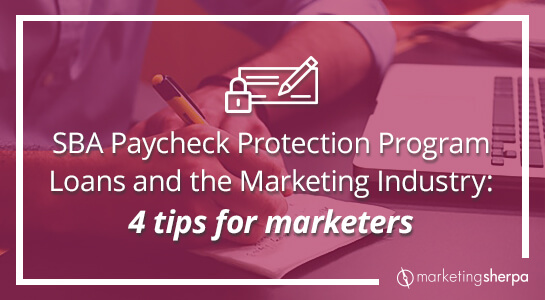SBA Paycheck Protection Program Loans and the Marketing Industry: 4 tips for marketers

This blog post was originally published in the MarketingSherpa email newsletter.
If you haven’t already heard of the Paycheck Protection Program (PPP), it is part of $350 billion in aid the U.S. Congress allocated for small businesses in its recent stimulus bill (and more is being considered).
This program, in response to the economic devastation wrought by the Coronavirus (COVID-19) crisis, is meant to keep small businesses afloat as well as ensure workers on private payrolls continue to get paid.
If you want general information about the program, you can learn more directly from the U.S. Small Business Administration. In this MarketingSherpa blog post, we’ll focus on some tips that are especially relevant to marketers.
Tip #1: Understand how your workers are classified
There has been a lot of press about the PPP and how it can help small businesses cover payroll and operating expenses. For some in the marketing industry, there may be special considerations in how they should manage their organization’s human resources.
“Many marketing agencies have a lot of 1099 contractors; those freelancers are not covered under the agency’s PPP loans. Therefore, marketing agencies would have an easier time covering those types of expenses under the Economic Injury Disaster Loan Assistance Program,” advised Taylor Gibson, COO, Optima Office, an accounting firm.
Gibson advises that the Payroll Protection Program can be a better loan option if you have W2 employees since portions can be forgiven (more info below).
“You can get two-and-a-half times the qualifying monthly wages and benefits through the Paycheck Protection Program. Plus, the PPP does not require a personal guarantee — which the Economic Injury Disaster Loan Assistance Program does,” advised Gibson.
Tip #2: You may be a small business
Jay-Z once said, “I’m not a businessman, I’m a business, man!”
You may be a small business as well.
Sole proprietors, independent contractors and self-employed persons can apply to the PPP, according to the SBA website.
“If you own a one-person marketing agency and are a sole prop[rietor], then you likely do not have payroll costs in the same way. That being said, the loan amount that you are eligible for would still be calculated as a result of your payroll costs for the twelve months,” said Allan Givens, PR Manager, Finder.com, which offers a tutorial on How to apply for the SBA Paycheck Protection Program.
Tip #3: Loan forgiveness is not automatic
One very appealing element of the PPP is that some of your expenses may be forgivable. In other words, the U.S. government may pay for some of your on-going business expenses for two months without requiring repayment.
According to the U.S. Treasury, once a loan is acquired, some of the costs that can be forgiven include most payroll costs, mortgage interest, rent and utility costs over an eight-week period if loan proceeds are used to pay for those things.
But again, there are rules and stipulations so make sure you understand them. For example, employee and compensation levels must be maintained. And even then, there are income limits.
Notice I say “may.” It is not automatic, so don’t take it for granted.
Even for costs that do qualify, Gibson recommends that you closely track qualifying PPP expenses.
“Create a new general ledger account to track all of your expenses you’ll pay out through Paycheck Protection Program, so that in June when you apply to have the loan forgiven, it’ll be easy to identify all of your expenses and ensure that at least 75% of those expenses are going to payroll and benefits. Make sure to look at all benefits, like your contributions to your employees’ 401(k) plans — note [that] contributions to a Roth IRA [do not] count in this formula,” he said.
Tip #4: Get your mojo back, whether your company applies for PPP or not
COVID-19 has been a body blow for many companies. Most of the economic news has been downbeat. As Robert J. Shiller explains in the book Narrative Economics, economies don’t just rise and fall because of fundamentals. The story the business community collectively believes has a huge impact (sound familiar marketers?)
So much cash going to so many companies could bring a new dawn to this economy.
Plus, even in good times small companies can be cash hungry, have cash flow issues or seek funding, so this infusion could help get them into a better position to invest.
Could marketers turn this into something positive even if their companies don’t apply for or don’t qualify for the Paycheck Protection Program?
“Since the PPP is essentially a forgivable loan, it’s likely that small businesses may increase their marketing spend once receiving it, because for all intents and purposes the PPP is free grant money, especially for businesses which were already profitable regardless of the economic downturn,” said Calloway Cook, President, Illuminate Labs, which sells and manufactures third-party tested herbal extract supplements.
“I think it will be a great time to pitch to prospective clients when and if many small U.S. businesses begin receiving their PPP funds,” he said.
You can connect with Daniel Burstein, Senior Director, Content & Marketing, MarketingSherpa and MECLABS Institute, on Twitter @DanielBurstein.
You might also like …
The Marketer and Buyer Anxiety: Three ways to counter anxiety in the purchase funnel
41 Work-From-Home Tips for Marketing Departments and Advertising Agencies
Marketers Stand Together: 3 powerful ways your marketing can combat coronavirus COVID-19’s impact
Categories: Marketing B2B marketing strategy, b2c marketing, business loan, coronavirus, COVID-19, economic crisis, marketing strategy, SBA Paycheck Protection Program









